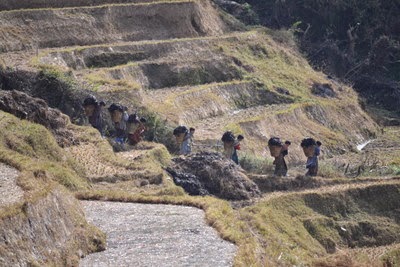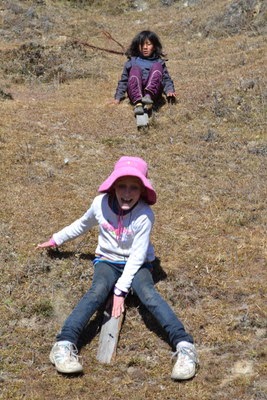After Phobjikha we headed off for some Western luxury at the Kichu Resort. We’d stayed there at the start of the year with all the BCF teachers as we were being deployed from Thimphu. It certainly gave me a sense of having come full-circle and made me ponder on the year that has been.
It also vividly illustrates just how altitude affects climate. At 2900m, Chumey, Bumthang is already quite cold and you certainly need to rug-up in the evening. Kichu was warm and sunny and a t-shirt would suffice for most of the day.
Now Kichu resort is very close to the village of Nobding which is famous for its er.......(how can I say this politely) pictures of nobs! The phallus is a good-luck symbol in many Buddhist countries and particularly so in Bhutan. There was a Tibetan Monk called Drukpa Kinley (also known as the Divine Madman) who visited Bhutan centuries ago. He was famed for his particular brand of anarchic wisdom. He was able to perform all sorts of miracles and spent much of his time bedding women, drinking chang (wine) and subduing demons with his ‘thunderbolt’. One theory for the popularity of the phallus in Bhutanese culture is that Drukpa Kinley used his thunderbolt to perform miracles. Thus many people paint phalluses on their houses or have wooden phallus sculptures adorning their homes to ward off evil.
Kichu Resort is very close to Samtengang where Vicky and Ian (fellow BCF teachers from Australia) live. We have visited them before and they always overwhelm us with their generous hospitality and great home cooking. I’ve blogged before about the village of rammed earth houses near their home and it was great to be able to visit once again – this time with the in-laws. A particular highlight of this visit was when a bunch of women who were ‘ramming’ the wall of a house under construction invited Justine’s stepfather (also Ian) to come and join them. He happily joined in – much to their delight. You get the impression that life may be tough in the village, but everyone seems to be busy and there is a tremendous community spirit that seems to make it a very special place indeed.
 |
| Justine poses before a rammed earth house under construction |
 |
| Ian joins the ladies for some ramming |
 |
| another lady in need of a wheelbarrow |
 |
| Samtengang - boys having fun with simple home-made toys |
 |
| Drying rice in Samtengang |
 |
| Workers at Samtengang ready to begin fertilising |
On Friday 12 December we headed off again for a one hour journey to the Meri Pusan Resort near Punakha. Our fellow BCF teacher Mackenzie, the youngest and tallest of our group met up with us for the day and it was great to spend some time again with him before he jetted off back to Alberta, Canada. He was a particular favourite with our kids and they always seemed to want to climb all over him – all three at the same time. Thanks to BCF, we now know several very nice Canadians dotted all over the country and Justine and I are already thinking how pleasant it would be to one day do a grand tour of Canada visiting our friends and colleagues along the way.
 |
| Justine and Mackenzie at the Yak Herders Camp |
 |
| Robyn, Punakha Dzong |
We had to visit Punakha Dzong one last time and of course it was the first time for Justine’s mum and stepfather. It is generally accepted to be Bhutan’s most beautiful dzong and it is a truly spectacular building. The main altar room is stunningly beautiful and one cannot help but be in awe of its tranquil grandeur. Mackenzie made me chuckle by bursting into a rendition of ‘Let Me See Your Dzong’. This prompted us to try and think of a few more western songs with a Bhutanese twist. We managed to come up with: ‘You’ve Gotta Gho Now’; Wake Me Up Before You Momo; and (my favourite) ‘Come On Baby Light My Bukari’.
 |
| The Divers at Punakha Dzong |
 |
| The Divers and Robyn at Punakha Dzong |
No interesting stories to tell about our accommodation at the Meri Pusan. It is a very nice resort and it was good to finally see a place with quite a few guests (so many hotels and resorts seem to be almost empty). I’d happily recommend the place to anyone travelling this way but again I make the point that such resorts are very pleasant and clean and the food is good but what you don’t get is an authentic feel and you don’t come away with any quirky, special memories. We have one more homestay booked in Haa. By then Justine’s brother Brendan will have arrived and we thought that he ought to experience a bit of genuine Bhutanese hospitality too.
 |
| Amelie on the bridge at Punakha Dzong |
One story I forgot to mention earlier was that at our second homestay in Phobjikha, Justine told our kids to go and wash their hands once she saw dinner was being served. Our hostess quickly interjected that they didn’t need to wash their hands because she had spoons for us to use.
Now once again, I’d had a mild bout of tummy trouble and perhaps this is what so inspired my daughters to add to that illustrious body of work – the diarrhoea poem. You may remember from your younger days: “Some people think it’s funny, but it’s really brown and runny – Diarrhoea! Diarrhoea!
Well, Amelie in particular has been inspired to add to the genre and I end this blog post now with a few poems from her growing anthology. There was a little bit of help from Mum and Dad admittedly and I accept full responsibility for any crudity or slightly inappropriate language.
Once again I issue a warning:
Some adults will find the below poetry offensive but just about all kids will find it hilarious.
When you’ve been on the toilet all day
And all your friends have run away
Diarrhoea! Diarrhoea!
When you’re at the school dance
And there’s something smelly in your pants
Diarrhoea! Diarrhoea!
When you’re sitting on the bog
And it’s liquid not a log
Diarrhoea! Diarrhoea!
Is it solid? Is it gas?
No it’s liquid out your ass!
Diarrhoea! Diarrhoea!


























